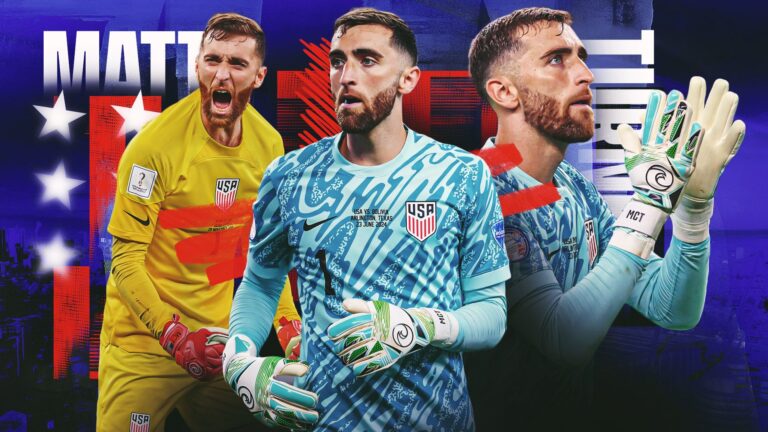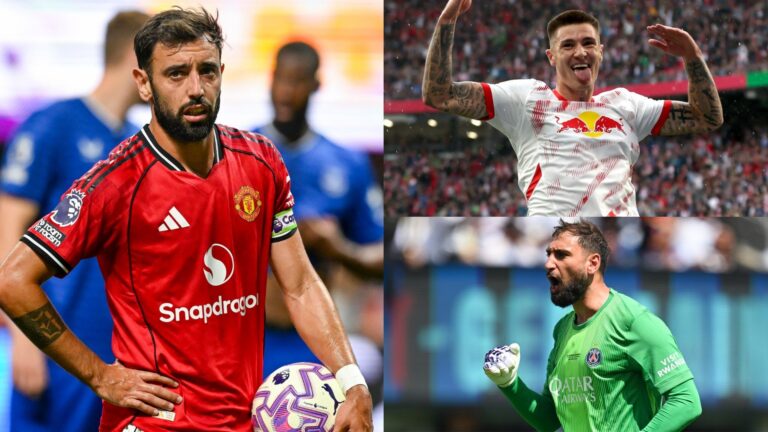Liverpool fans have always enjoyed singing "The Reds have got no money but we’ll still win the league", and last season’s Premier League title triumph was certainly notable for the fact that it was achieved with just one summer signing in Federico Chiesa – who cost just £10 million ($13.5m) and barely played.
However, the idea that the club is strapped for cash has always been grossly misleading. Liverpool’s owners, Fenway Sports Group (FSG), aren’t poor; they’re prudent. When there has been a need – or indeed an opportunity – to spend big on a potential game-changer, the Americans have been very willing to stump up the cash.
Remember, record-breaking fees were paid for Virgil van Dijk and Alisson Becker in 2018 and laid the foundation upon which Jurgen Klopp’s era of sustained success was constructed, while the midfield overhaul in the summer of 2023 undeniably played a pivotal role in Liverpool running away with the league last season.
However, no previous splurge even comes close to the spending spree FSG have sanctioned during the current summer transfer – which isn’t even over yet. Indeed, with more than five weeks to go until deadline day, Liverpool have already spent a staggering £265m ($359m) – and that’s without getting into add-ons and bonuses.
So, how are the Reds paying for all of these new players? Will they now need to sell to balance the books? And could there actually be even more new arrivals before the close of the window on September 1?







Liverpool fans have always enjoyed singing “The Reds have got no money but we’ll still win the league”, and last season’s Premier League title triumph was certainly notable for the fact that it was achieved with just one summer signing in Federico Chiesa – who cost just £10 million ($13.5m) and barely played.
However, the idea that the club is strapped for cash has always been grossly misleading. Liverpool’s owners, Fenway Sports Group (FSG), aren’t poor; they’re prudent. When there has been a need – or indeed an opportunity – to spend big on a potential game-changer, the Americans have been very willing to stump up the cash.
Remember, record-breaking fees were paid for Virgil van Dijk and Alisson Becker in 2018 and laid the foundation upon which Jurgen Klopp’s era of sustained success was constructed, while the midfield overhaul in the summer of 2023 undeniably played a pivotal role in Liverpool running away with the league last season.
However, no previous splurge even comes close to the spending spree FSG have sanctioned during the current summer transfer – which isn’t even over yet. Indeed, with more than five weeks to go until deadline day, Liverpool have already spent a staggering £265m ($359m) – and that’s without getting into add-ons and bonuses.
So, how are the Reds paying for all of these new players? Will they now need to sell to balance the books? And could there actually be even more new arrivals before the close of the window on September 1?
Liverpool’s club-record outlay for a single window has astounded a lot of Reds – particularly those that previously criticised FSG for their perceived parsimony. Within certain sections of the fanbase, there was a belief that former boss Klopp could have won even more trophies had he been backed to the same extent in the transfer market as Pep Guardiola, the manager of Liverpool’s great rivals Manchester City. However, Kieran Maguire, author of ‘The Price of Football‘ and co-host of the podcast of the same name, says that the majority of Reds have always understood and appreciated how well their club is run.
“Whenever I go to Anfield and meet Liverpool fans, they always strike me as one of the most knowledgeable sets of supporters out there,” he tells BALLGM. “But that’s the people going to the ground every week. The eejits on social media are the problem. They think that the solution to everything is spending £200m on as many players as possible in each and every window. As a result, these fans make an awful lot of noise on social media – without having any knowledge of how to run a football club.
“I mean, if I go and watch a re-run of ER, it doesn’t make me a medical expert! But you’ve got this situation where a person that has won five league titles in a row with Liverpool on FIFA thinks he knows as much as the professionals calling the shots at Anfield. It’s lunacy.
2I would urge anyone who has criticised Liverpool to read Ian Graham’s book ‘How to win the Premier League’ – because the club’s approach is brilliant. It’s basically, ‘We will only bring players in if they’re of net benefit to the club.’ And that’s it, it’s that simple. Crucially, though, the coach agrees with that approach, the directors agree with it, and the money men agree with that. Basically, at Liverpool, everyone is rowing in the same direction.”
Maguire’s insight helps explain why there was no sense of panic at Anfield last summer while those on the outside were once again lamenting Liverpool’s failure to sign a defensive midfielder.
Sporting director Richard Hughes, who had only just arrived from Bournemouth, thought he had wrapped up a deal for Martin Zubimendi – only for the Spain international to perform a dramatic, eleventh-hour U-turn and decide to stay at Real Sociedad. Liverpool had no Plan B either. There was no Zubimendi alternative, which seemed strange. But Hughes and the rest of the Reds’ recruitment team clearly didn’t feel that there was another No.6 on the market capable of improving Slot’s squad – and they were right.
As it transpired, Liverpool were already in possession of a solution to their defensive midfield problem – and Slot found it. The Dutchman’s decision to deploy his compatriot Ryan Gravenberch in front of the back four proved an absolute masterstroke – as underlined by the Bayern Munich flop being crowned the Premier League’s Young Player of the Season for the pivotal part he played in Liverpool’s championship success.
A lot of other coaches would have reacted very negatively to being given just one signing to work with at a new club (Antonio Conte immediately comes to mind!), but Slot simply got on with the task at hand – just as he had always done at Feyenoord, where he had overachieved with fewer resources than traditional rivals Ajax and PSV. In fact, Slot’s resourcefulness was one of the key reasons why Liverpool hired him, so his problem-solving skills came as no surprise to Michael Edwards u0026amp; Co.
Of course, it also helped that Klopp had left Liverpool in rude health – something that Slot acknowledged in several press conferences. As he repeatedly pointed out, it isn’t easy to improve an already-strong squad. However, the plan was always to bring in new players at the end of the 2024-25 campaign – no matter how well the season had gone.
As transfer market reporter Ben Jacobs tells BALLGM “FSG are always willing to back Liverpool managers when there is a need to do so – and this is a time when Liverpool feel they need a revamp. There are several reasons for that, but I think the main thing is that Richard Hughes is settled into his role now and we’re also a year into Slot’s reign, so he’s had time to assess his squad and see what else he needs.
“The first priority was obviously keeping Mo Salah and Virgil van Dijk. The second was adding to the squad – and Liverpool wanted to do that now so that there was effectively an overlap, meaning the players that have come in will be effectively competing for a starting spot with those that they’ll end up replacing. For example, they’ve brought in Giorgio Mamardashvili while Alisson is still there, and they’ve brought in Milos Kerkez while Andy Robertson is still there – and this is the Liverpool way.
“They’re going big now in order to overhaul the squad before there’s a drastic need to overhaul the squad. And that takes the pressure off the players coming in, because they won’t be thrown straight in at the deep end. I think that Liverpool also realise that if they don’t make these signings now, during a summer when other Premier League teams are spending big, there is a risk of losing your status as the best team in England.
“So, there’s an element of urgency – but Liverpool’s particularly brand of urgency has always been very calm and considered. They move quietly in the market and ignore a lot of the noise.”
As Jacobs says, Liverpool have long been lauded for the swift and discreet way in which they go about their business. For example, the signing of Alexis Mac Allister was effectively sealed before the 2023 summer transfer window had even opened.
Liverpool, though, have outdone themselves this time around. The arrival of Mamardashvili from Valencia was agreed last year, while they had two new full-backs in the door by June 23. Jeremie Frimpong actually joined on the same day that the man he was replacing, Trent Alexander-Arnold, completed his transfer to Real Madrid, while it had been clear for some time that Kerkez’s move from Bournemouth was a done deal.
However, if neither of those signings came as much of a surprise, Liverpool’s acquisition of Florian Wirtz on June 20 stunned the football world. Even as recently as May, nobody had any idea that the Reds were even with a shout of landing the Germany international, who seemed far more likely to end up at Manchester City or Bayern Munich – if Bayer Leverkusen were even willing to let him leave at all.
That Liverpool managed to convince Wirtz to move to Merseyside was one thing, though; it was the fact that FSG funded a potential British-record £116m ($257m) was quite another that really attracted attention. However, as Jacobs points out, the money had always been there for a nine-figure fee.
“We already knew that they were willing to spend £100m on a player because they tried to sign Moises Caicedo a couple of years ago, while they also made a big bid for Romeo Lavia during the same window,” he says. “Both of those players ended up going to Chelsea, meaning that money stayed in the piggy bank, so to speak, with the idea being that they would spend those funds at a later date if the right player became available.
“The other factor in Liverpool being able to move so quickly and spend so much money in the current window is that they’re compliant with the Premier League’s Profit u0026amp; Sustainability (PSR) rules. They closed their 2024-25 financial year in May, whereas most other clubs didn’t do so until June, and if you do that in May, it means you’re satisfied, you’re PSR-compliant, so you can get moving in June to get deals done quickly, as you’re putting all that cost onto your next financial year.
“By contrast, other clubs with a tighter PSR top-line are worried about doing business in June and are waiting until July, and I think that was definitely the case with Manchester United and very possibly Arsenal. So, if you’ve got the kind of financial headway that Liverpool have, it can give you a bit of a head-start in the market because you can get going on deals quickly, while maybe some of your main rivals have to be more patient.”
Of course, Liverpool’s business has only become an even bigger talking point over the past few weeks – because it’s not as if they stopped spending in June. On Wednesday, they paid an initial £69m ($93m) to Eintracht Frankfurt for France Under-21 international Hugo Ekitike – and the belief is that more new players will arrive before deadline day.
So, is there a risk of Liverpool creating a PSR problem for themselves unless they start selling players such as Harvey Elliott and Luis Diaz to balance the books?
“The only reason why anyone will leave Liverpool between now and the end of the window is because they’re surplus to requirements,” Maguire insists. “They’ll be leaving for footballing reasons as opposed to financial reasons. That’s how strong a position they’re in.
“Under the PSR rules, you’re allowed to lose £105m ($142m) over the preceding three years. In Liverpool’s case, they’ve lost £75m ($100m) over the past three years, but by the time you add back the academy costs, infrastructure costs and women’s team, they’re actually in a positive position from a PSR perspective.
“People forget that they didn’t spend any money last season and then they won the league, so they’ve got bonuses from Standard Chartered, extra money from the Premier League for finishing first and they’ll get extra money from UEFA when they enter the Champions League this season, so all of these things are going to throw in an extra five or 10 million pounds here, there and everywhere.
“Alexander-Arnold is also gone, so that’s saving them about £200,000 ($270,000) a week, while they’ve already sold a reserve goalkeeper (Caoimhen Kelleher) and their third- or fourth-choice centre-back (Jarell Quansah) for approximately £42.5m ($57.5m) – and that’s pure profit because they were two academy players. So, all things considered, Liverpool could spend another £150m without running into any PSR issues.”
There is, then, every chance that a sensational summer window for Liverpool could be about to get even better, as there is still sufficient wiggle room within the budget to not only bring in a centre-back – but also realise their dream deal.
The Reds’ interest in Alexander Isak is long-standing and enquiries were made before the hijacking of Newcastle’s move for Ekitike. The common consensus was that the signing of the French forward would signal the end of the transfer talk surrounding Isak. However, the striker was left out of Newcastle’s first game of pre-season because of the speculation surrounding his future, and it was then confirmed that Isak would not travel with the rest squad on their tour of Asia due to a thigh problem.
By that stage, it was clear that the Swede was unsettled at St. James’ Park, and it was revealed later on Thursday that he had informed his employers of his wish to leave.
Admittedly, even if Newcastle were to cede to his request, they would doubtless demand a fee in excess of £120m ($162.5m) for Isak, but Maguire is adamant that the price wouldn’t be a problem for Liverpool.
“One thing a lot of people overlook or don’t know is that when you buy a player, you’re spreading the cost of the transfer over a set amount of years, usually five. So, for example, Wirtz cost an initial £100m ($135m) – but that works out at £20m ($27m) per year in terms of their PSR calculation,” Maguire explains. “But Liverpool have already sold Quansah for £30m ($40m), so they’re actually financially better off if you’re just looking at those two deals alone.
“And one other very important thing to remember in all of this is that Michael Edwards is not an idiot. On the contrary, he’s a very smart man and Liverpool are spectacularly well-organised. Now, whether Liverpool can convince Newcastle to sell Isak at this stage is one thing. But the key point is that if they want to sign him, that wouldn’t be a problem for them at all from a financial perspective.”
Basically, the Reds have got the money – and could well win the league again.









